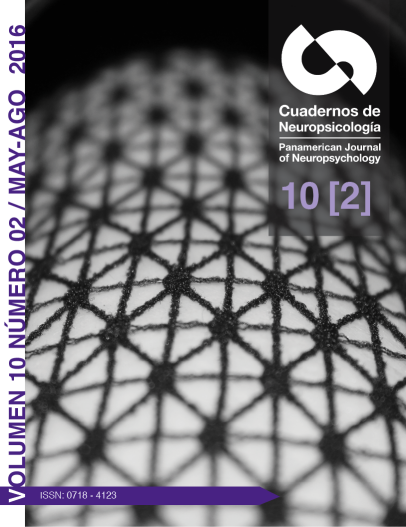NeuropsicologÃa de la inteligencia limÃtrofe
Abstract
RESUMEN
La inteligencia limÃtrofe no es un trastorno mental, es una forma de funcionamiento intelectual caracterizado por dificultades en el aprendizaje y en el procesamiento cognitivo, siendo una de las principales causas de bajo desempeño y fracaso escolar. Se hace necesario comprender el perfil neuropsicológico de estos niños, con el fin de plantear rutas de intervención orientadas a diseñar estrategias que favorezcan su desempeño escolar y su inclusión al entorno. Objetivo: Identificar las caracterÃsticas neuropsicológicas en niños, niñas y adolescentes con capacidad intelectual limÃtrofe en una muestra de pacientes en Sabaneta (Colombia). MetodologÃa: Estudio descriptivo, retrospectivo, de fuentes secundarias, para una sola muestra de niños, niñas y adolescentes con diagnóstico de capacidad intelectual limÃtrofe que asistieron a evaluación neuropsicológica durante un perÃodo de tiempo de 3 años (n= 73). Resultados: Se encontró una distribución por género del 74% en el sexo masculino y 26% en el sexo femenino. El 67,1% de los pacientes presentó comorbilidad, siendo el Déficit de Atención con Hiperactividad (TDAH) el trastorno con mayor frecuencia (32.9%). Discusión: Los hallazgos obtenidos en esta investigación coinciden con lo encontrado en la literatura sobre el tema.
Palabras claves: NeuropsicologÃa; Trastornos del Aprendizaje; Inteligencia; Procesos Cognitivos; Trastornos Mentales; Historias ClÃnicas.
Â
ABSTRACT
The borderline intelligence is not a mental disorder, is a form of intellectual functioning characterized by difficulties in learning and cognitive processing, being one of the major causes of academic failure. According to this, overcomes a necessity of understanding the neuropsychological profile of these children, in order to create routes of intervention oriented to improve school performance and their environmental inclusion. Aim: To identify the neuropsychological features of children and adolescents with borderline intellectual functioning in Sabaneta (Colombia). Methodology: A descriptive study - retrospective secondary sources for a single sample of children and adolescents who met diagnosis criteria for a borderline intellectual functioning, who attended neuropsychological evaluation in a period of three years (n = 73). Results: A Gender distribution of 74% in males and 26% in females. Attention Deficit Hyperactivity Disorder (ADHD) was the most frequent disorder (32.9%), and 67.1% of patients had comorbidity with it. Discussion: The obtained results coincide with those found in the literature on the subject.
Keywords: Neuropsychology; Learning Disabilities; Intelligence; Cognitive Processes; Mental Disorders; Medical Records.
Â
RESUMO
A inteligência limÃtrofe não é um trastorno mental, é uma forma de funcionamento intelectual caracterizado por dificultades na aprendizagem e no processamento cognitivo, sendo uma das principais causas de baixo desempenho e fracasso escolar. Faz-se necessário compreender o perfil neuropsicológico destas crianças, com o fim de promover rotas de intervenção orientadas a desenhar estratégias que favoreçam seu desempenho escolar e sua inclusão ao redor. Objetivo: Identificar as caracterÃsticas neuropsicológicas em meninos, meninas e adolescentes com capacidade intelectual limÃtrofe numa população de Sabaneta (Colombia). Metodologia: Estudo observacional - descritivo cross sectional para uma só amostra de meninos, meninas e adolescentes com diagnóstico de capacidade intelectual limÃtrofe que assistiram a avaliação neuropsicológica durante um perÃodo de tempo de 3 anos (n= 73). Resultados: Encontrou-se uma distribuição por gênero de 74% no sexo masculino e 26% no sexo femenino. 67,1% dos pacientes apresentou comorbilidade, sendo o Déficit de Atenção co Hiperatividade (TDAH) o transtorno com maior frequência (32.9%). Discussão: Os achados obtidos nesta investigação coincidem com o encontrado na literatura sobre o tema.
Palavras-chave: Neuropsicologia; Transtornos de Aprendizagem; inteligência; processos cognitivos; transtornos mentais; Registros médicos.
Downloads
How to Cite
Issue
Section
License
Articles published in this journal are protected under the Creative Commons Attribution-NonCommercial-ShareAlike 4.0 International (CC BY-NC-SA 4.0) license. This means that authors retain full rights over their research and publications at all times. As a journal, we fully respect and promote the principles of open access established by this license, allowing the work to be shared, adapted, and distributed for non-commercial purposes, provided that appropriate credit is given to the authors and any derivative works are licensed under the same terms.
Authors are responsible for obtaining the required permission when they wish to reproduce part of the material (figures, etc.) from other publications.
Likewise, CNPs allows authors to host in their personal sites or other repositories that they deem convenient the Final and Definitive Version of the published article with the format assigned by the journal. In no case do we allow access to preprints of the article under evaluation or already published.
When submitting an article to CNPs you are aware that all the contents of CNPs are under a Creative Commons License. In which it is allowed to copy and share the contents freely, always making reference to the origin of the publication and its author.





